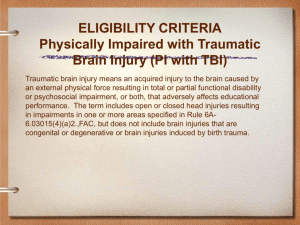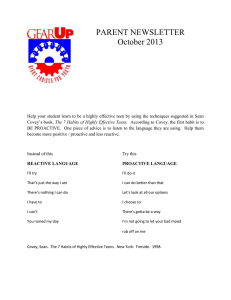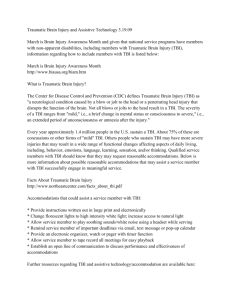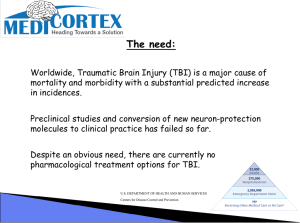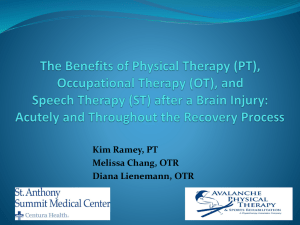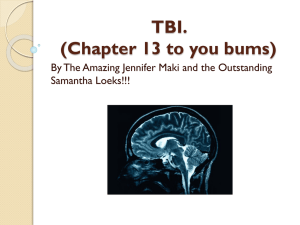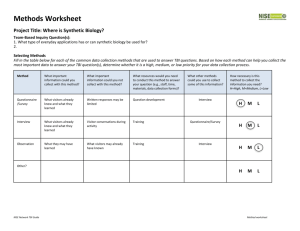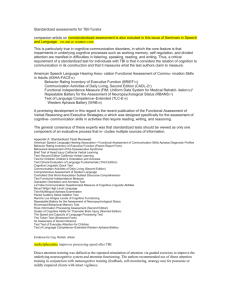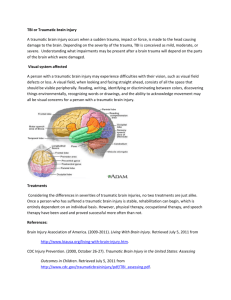Power Point Presentation
advertisement
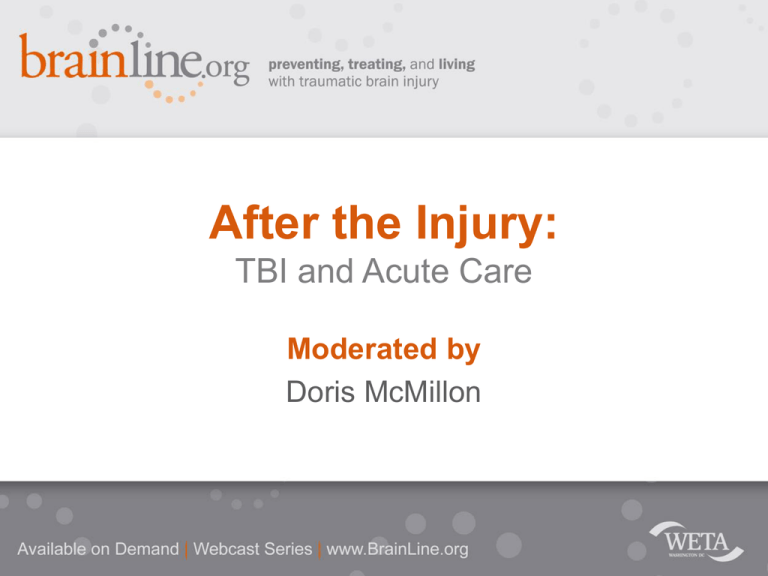
After the Injury: TBI and Acute Care Moderated by Doris McMillon Featuring Jeffrey Bazarian, MD an emergency physician with a strong research interest in traumatic brain injury. He is associate professor of Emergency Medicine, Neurology, and Neurosurgery at the Center for Neural Development and Disease, University of Rochester Medical Center. James M. Ecklund, MD a neurosurgeon and currently the chairman of the Department of Neurosciences at Inova Fairfax Hospital, Virginia’s largest Trauma Center. His research interests include neurotrauma with an emphasis on blast and penetrating injury. Maria Mouratidis, PsyD a clinical neuropsychologist and the command consultant and subject matter expert for traumatic brain injury and psychological health at the National Naval Medical Center. She is regarded as a national expert and lectures widely on the areas of traumatic brain injury and psychological health. After the Injury: TBI and Acute Care Featuring Jeffrey Bazarian, MD an emergency physician with a strong research interest in traumatic brain injury. He is associate professor of Emergency Medicine, Neurology, and Neurosurgery at the Center for Neural Development and Disease, University of Rochester Medical Center. James M. Ecklund, MD a neurosurgeon and currently the chairman of the Department of Neurosciences at Inova Fairfax Hospital, Virginia’s largest Trauma Center. His research interests include neurotrauma with an emphasis on blast and penetrating injury. Maria Mouratidis, PsyD a clinical neuropsychologist and the command consultant and subject matter expert for traumatic brain injury and psychological health at the National Naval Medical Center. She is regarded as a national expert and lectures widely on the areas of traumatic brain injury and psychological health. After the Injury: TBI and Acute Care In ER, main causes of TBI • Car and motorcycle crashes • Falls • Most TBIs seen in the ER are on the more mild end of the spectrum. After the Injury: TBI and Acute Care Short video on what happens to the brain at point of impact and injury This clip from “Understanding Traumatic Brain Injury” was produced by the Defense and Veterans Brain Injury Center. www.dvbic.org After the Injury: TBI and Acute Care What ERs need for best outcome • Ability to perform CAT scan • Staff neurosurgeon on stand-by to remove blood clots, if necessary (Blood clots can be life threatening.) After the Injury: TBI and Acute Care First concerns when someone is brought into ER • • • • Securing the person’s airway so he or she can breathe Maintaining blood pressure Performing CAT scan, if necessary Performing physical and cognitive tests, if person is able After the Injury: TBI and Acute Care Current research for diagnosis of TBI Research is being done on creating a blood test — a biomarker — that would determine if there has been an injury to the person’s brain. After the Injury: TBI and Acute Care Ways medical team can help families It is important for the medical team to include the family immediately when a loved one is in the ER. The team can do this by • educating the family about brain injury, the recovery process, and treatment. • recognizing and validating their feelings and anxieties during this time of crisis. • helping them manage their expectations about the outcome for their loved one. • involving them as much as possible in the treatment plan for their loved one. • connecting them with resources like chaplains, counselors, and others on the multidisciplinary team. After the Injury: TBI and Acute Care First steps neurosurgeons take when someone is admitted into ER with TBI • Perform neurologic exam • Check person’s level of consciousness, pupil reaction, and whether there is weakness on one side of the body or the other • Evaluate CAT scan • Review tests and scans to determine next best course of care After the Injury: TBI and Acute Care First steps neurosurgeons take when someone is admitted into ER with TBI (con’t) • Make sure person’s oxygenation is optimized • Make sure blood pressure is maintained • Check and recheck the basics of airway, breathing, circulation • Determine level of pressure in skull • Create as healing an environment as possible After the Injury: TBI and Acute Care When is surgery necessary? • If a blood clot or other mass is causing too much pressure on the brain • If the Glasgow Coma Scale is significantly low, a brain monitor will be surgically placed in the brain to measure the pressure. • If the brain is swelling too much, a surgeon can drain some of the fluid from the fluid sac. • If the brain is swelling intensely — as it can from blast injuries — a surgeon may perform a craniectomy. This procedure entails removing part of the skull to allow the brain to swell into that portion to save the person’s life and provide the ability to recover. After the Injury: TBI and Acute Care Similarities between blast injuries and car crashes • Impact injury if the head strikes an object • Deceleration/acceleration-type injury or rotation-type injury After the Injury: TBI and Acute Care Differences between blast injuries and car crashes • Penetrating injuries can be associated with blast injuries. • In “primary blast injuries,” over-pressure waves are involved. These kinds of waves can affect air-filled cavities in the body like the lungs and bowel; there is research being done on their effect on solid organs like the brain. • Other influencing factors in a blast injury can include toxic effects, electromagnetic pulse, and heat that is generated from the blast. • The brain swells far more from a blast injury than from a car crash. After the Injury: TBI and Acute Care Promising areas of research Current studies are looking into • why there is more (edema) swelling to the brain after a blast injury, and more increased blood flow on the surface of the brain in comparison with other brain injuries. • the use of functional MRI, which would provide a more multi-layered image for more successfully determining prognosis. • the use of a Transcranial Doppler, a measure of blood flow that would help determine prognosis and ultimately improve care. After the Injury: TBI and Acute Care Short video on group of teenagers who met in rehabilitation after sustaining TBIs This clip from “The Other Breakfast Club” was produced by the National Road Safety Foundation. www.nationalroadsafety.org After the Injury: TBI and Acute Care Role of neuropsychologists Neuropsychologists play a key role in the multidisciplinary medical team by helping people with TBI and their families • • • • get educated. develop appropriate expectations. find some semblance of normalcy during the time of crisis. focus forward, focus on their strengths and what they can do and less on who they used to be. • find support on as many fronts as possible. After the Injury: TBI and Acute Care Role of neuropsychologists (con’t) • Neuropsychologists also help • assess the person’s cognitive and emotional functioning … how his or her brain is working — from thinking and feeling to working on challenges with memory and attention. • create a treatment plan for the person with TBI to restore function or to compensate for lack of function in various areas — from walking and learning balance to developing strategies for short-term memory loss. After the Injury: TBI and Acute Care How are symptoms different for TBI and PTSD? • A lot of research is still being done on the subject. • What is most important is treating the symptoms and addressing the difficulties the person is having regardless of the cause. After the Injury: TBI and Acute Care In reaction to current wars, have protocols or tests changed? Several tests have become mandatory when soldiers return from theater. • Audiology testing (blasts can damage ear drums) • Dental examinations (blasts can cause cracked teeth or expose nerves in teeth) • Eye examinations • Full mental health evaluations • Full neuropsychological testing Protocols for pain management are also being looked at carefully. After the Injury: TBI and Acute Care Depression, divorce, and sexual dysfunction It is important to educate families about issues like depression, divorce, and sexual dysfunction which can result after TBI. • Families need to be aware of these issues so they can recognize them, find resources, and take action if necessary. • Every person and family is different; issues can arise in the short- or long-term. After the Injury: TBI and Acute Care Questions from the audience When is someone with a severe brain injury considered out of the woods? After the Injury: TBI and Acute Care Questions from the audience (con’t) Does talking to someone while they’re in a coma help, and can he or she hear? After the Injury: TBI and Acute Care Questions from the audience (con’t) How can early diagnosis help improve how someone does over the long term? After the Injury: TBI and Acute Care Questions from the audience (con’t) What plans are in the works to provide long-term community support services for military veterans and how will that support be funded? After the Injury: TBI and Acute Care Questions from the audience (con’t) What long-term issues do you think veterans from the current wars will be dealing with down the road? After the Injury: TBI and Acute Care Final thoughts • Although most people recover rapidly from a concussion, not all mild TBIs are mild. Long-term symptoms can persist, which is why it is important for people to go to the ER as quickly as they can after a TBI to get a CAT scan and/or educational advice. • Although TBI continues to be a significant problem in both civilian and military populations, there have been ameliorations in care and outcome in the last few decades. With continued innovation and research, outcome for people with TBI will continue to improve. • There is hope, and hope is renewed everyday. The ability of the body, mind, and spirit to overcome is tremendous. After the Injury: TBI and Acute Care Learn more To learn more about traumatic brain injury, signs and symptoms, treatment options, and ways to prevent it, please visit BrainLine is funded by the Defense and Veterans Brain Injury Center, the primary operational TBI component of the Defense Centers of Excellence for Psychological Health and Traumatic Brain Injury, through a subcontract award with the Henry M. Jackson Foundation for the Advancement of Military Medicine. After the Injury: TBI and Acute Care Acknowledgment of Support and Disclaimer This material is based upon work supported by the USAMRAA under Contract Number W81XWH-07-C-0089. Any opinions, findings and conclusions or recommendations expressed in this material are those of the author(s) and do not necessarily reflect the views of the USAMRAA. © Greater Washington Educational Telecommunications Association, Inc., 2008
